《英汉互译》教案与讲义第6讲
《英汉互译(二)》教案与讲义第4讲
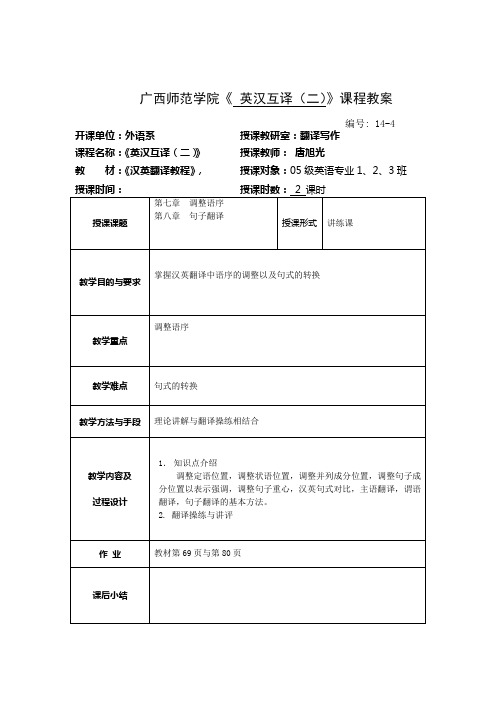
广西师范学院《英汉互译(二)》课程教案编号: 14-4 开课单位:外语系授课教研室:翻译写作课程名称:《英汉互译(二)》授课教师:唐旭光教材:《汉英翻译教程》,授课对象:05级英语专业1、2、3班英汉互译(二)第4讲第一步:上周练习讲评:第二步:本周课堂内容呈现第七章调整语序语序的调整英、汉相同点:“主语+谓语+宾语”(SVO)或“施事+行为+受事”为基本语序英、汉相异点:句内的语序的灵活性,以及定语、状语等次要成分位置的差异,汉译英需要调整语序句内主要成分位置的调整沙发上坐着一个人。
A man was sitting on a couch.马可·波罗的中国之行,给他留下最深刻印象的是杭州西湖之秀美。
The beauty of the West Lake in Hangzhou was what impressed Marco Polo most during his trip to China. 一、调整定语位置1.单词定语位置的调整1)单词定语所修饰的词为some, any, no, every等构成的复合代词时,定语可后置;2)某些以-ible 或–able结尾的形容词作定语,尤其与every, the only, 或形容词最高级连用来修饰名词时,常常后置。
3)通常作表语用的形容词在作定语时,习惯后置;4)某些分词作定语时,常常后置;5)某些表示位置、方向的副词作定语时,往往后置;6)某些固定词组,其形容词休饰语放在名词之后;7)名词有几个形容词作前置定语,按照亲疏关系、单词长短予以排列;2.短语定语位置的调整3.定语从句位置的调整二、调整状语位置汉语状语的位置一般在主语和谓语之间,呈“主语→状语→谓语→宾语”模式;英语状语一般出现在宾语后的句尾,呈“主语→谓语→宾语→状语”模式。
1.副词状语位置的调整;2.一系列表示时间、地点、方式的状语位置的调整;在汉语中通常排列为“时间→地点→方式→动词”的顺序,而在英语中则通常排列为“动词→方式→地点→时间”的顺序。
英汉翻译教程unit6
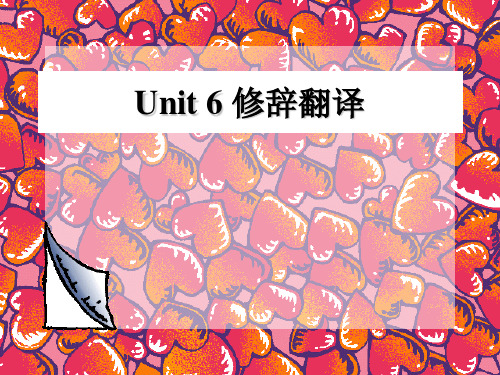
• 11. Thunder roared and a pouring rain started. • 试翻译:雷声怒吼中开始下起了倾盆大雨。(拟人) 试翻译:雷声怒吼中开始下起了倾盆大雨。(拟人) 。(拟人 • 12. It took a few dollars to build this indoor swimming pool. • 试翻译: 建一个室内游泳池只花几美元。(夸张) 。(夸张 试翻译: 建一个室内游泳池只花几美元。(夸张) • 13. To tell you the truth, I was really scared to death at that time. • 试翻译:说真的,我那时真是吓得要死。(夸张) 试翻译:说真的,我那时真是吓得要死。(夸张) 。(夸张 • 14. His words made my blood freeze. • 试翻译:听了他的话,我的血都快凝固了。(夸张) 试翻译:听了他的话,我的血都快凝固了。(夸张) 。(夸张 • 15. He threw a nervous glance at his brother. • 试翻译:他紧张地朝他的兄弟瞥了一眼。(移就) 试翻译:他紧张地朝他的兄弟瞥了一眼。(移就) 。(移就
• "You're giving me a pain in the neck," shouted Dr. Ruby, "Do you have a chip on my shoulder or something? Just laugh!" • 你是不是成心找不愉快 成心找不愉快? 成心找不愉快 • "I don't have a chip on my shoulder. Nothing is broken. I told you I have a sore throat and a pain in my knee." • "My knee only hurts when dance," said the doctor. "That's because I have two left feet." • 那是因为我笨手笨脚 笨手笨脚。" 笨手笨脚
新英汉翻译课件教程 Chapter 6 词义的处理
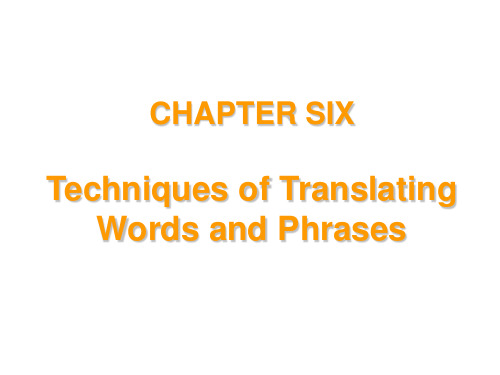
• 6. Although our country is economically better off than ever before, it has a way to go. • A.虽然我国的经济比以前有所前进,今后仍有很长的路要 走。 • B. 尽管我国的经济情况比以前有所好转,但仍有待进一 步发展。 • 。 • 7. These brightly colored stockings are all the go this summer. • A.这种色彩鲜艳的长筒女袜,只一个夏天就穿破了。 • B.这种色彩鲜艳的长筒女袜,今年夏天很流行。 • 8. The cooking was up to the hammer. • A.把饭倒在锤子上了。 • B.烹调是第一流的。
• 9. Everything was working very smoothly and I felt on top of the world. • A.一切进展顺利,我感到在世界顶端。 • B.一切进展顺利,我感到满意极了。 • 10. There is no provocation for such an angry letter. • A.没有理由写这样一封怒气冲冲的信。 • B.别写这样一封使人生气的信。 • C.不必对这样一封令人气愤的信而发火。
• 例3:She has given heart to him.
• 【误】她爱上了他。 • 【正】她鼓励了他。 • 【解析】“give heart to sb.” 意思是 “鼓励某人”,不 是“把心都给了某人”; “give one’s heart to sb.” 才 是 “爱上某人”。象这类词组还有 “give sb. a hand” “帮助某人”,而“give one’s hand to sb.” 便成了“同 意嫁给某人”;“serve time” “服刑”,而“serve one’s time”则为“处于学徒期”;“watch time” 意思 是“不要迟到”,而“watch one’s time” 则是“等待时 机”。要克服这方面的错误,必须加强语言修养,对词汇、 语法、惯用法等要细心研究,多琢磨思考。
英汉翻译教程第六章PPT

广告英语的翻译
• 总之,衡量广告翻译的优劣,主要看译文在多大 程度上体现了原文的宣传效果和表情、说服等功 能,多大程度上保留了原文的语言特色及神韵。 为此,翻译时选词上要力避生涩艰拗,造句上要 尽量简洁明快,修辞上要多保留原文辞格。译文 要注重整体把握,不为一词一句所限,要充分发 挥译者的主观能动性。此外,广告翻译还应充分 考虑中英两种语言间的文化差异。只有这样,才 能使译文体现原文的各项功能,为产品畅销打下 良好的基础。
商贸函电的翻译
• 下面是一份电传的主要部分及其参考译文: TKS F UR OFA BUT RGRTS UR PRICES TOO HIGH F OUR MKT, AS GDS OF JAPANESE MAKE WITH SimILAR DES R ON SALE HR AT MCH LOWER PRICES. IF U RDU UR PRICE BY 5PCT, V WL ODA 1000 SETS. PLS TAKE THIS MATTR INTO CONSIDERATION N RPL ASAP. RGDS.
商贸函电指经济贸易活动中的各类信函、电报、电传等。 其文体特征主要有: 1) 措词简洁明了。为使表达明晰,商贸函电在措词上力求 简明扼要,不太讲究修饰。 2) 用语正式庄重。正式庄重的语言常常显得诚恳、自然、 有礼貌,因此常用于商贸函电中。 3) 专业术语较多。如FOB(离岸价)、CIF (到岸价)、 settlement(理赔)、L/C(信用证)、AC(承兑)等。 4) 具有相对固定的格式。商贸函电格式相对固定,大体上 由以下六个部分组成: a. 信头(the heading) b. 信内地址(the inside address) c. 称呼(the salutation) d. 信文(the body) e. 结束语 (the complimentary close) f. 签名(the signature)
英汉翻译课程教案.docx
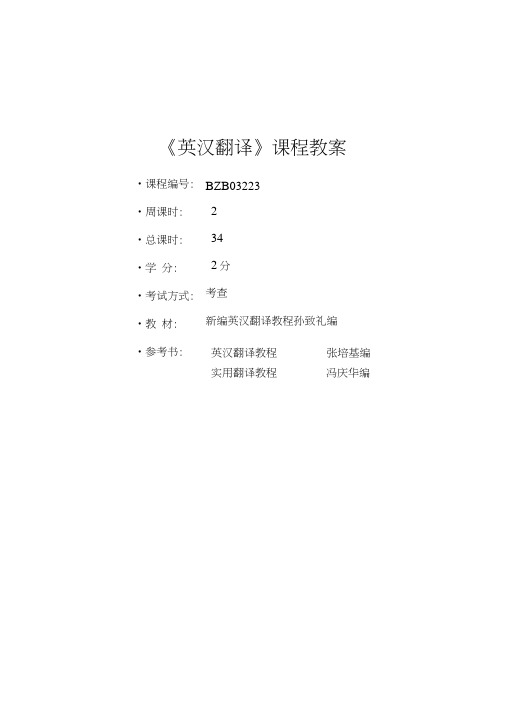
《英汉翻译》课程教案•课程编号: •周课时: •总课时: •学分: •考试方式: •教材: •参考书: BZB032232342分考查新编英汉翻译教程孙致礼编英汉翻译教程张培基编实用翻译教程冯庆华编ContentsChapter 1 What Is Translation (1)Chapter 2 The Process of Translation (15)Chapter 3 The linguistic Approach toTranslation (25)Chapter 4 Conversion (35)Chapter 5 The importance of diction (43)Chapter 6 Translation concerning negation (48)Chapter 7 Ampliflcation (53)Chapter 8 Repetition (58)Chapter 9 Changes of sentence parts (62)Chapter 10 Translation of attributive clause (66)Chapter 11 Translation of Long Sentences (69)Chapter 12外位语结构在英译汉中的应用 (73)Chapter 13 Translation of Passive Voice (77)Chapter 14 Translation of figures of speech (83)Chapter 15 Translation of idioms (87)Chapter 1 What Is TranslationAims: To understand the basic principles of translation and translation studiesKey points: the nature of translation, definition of translationDifficulties: the nature of translation, history of translationTeaching procedures1.The nature of translation•Translation is of great importance in learning a foreign language. Many of those who learn English will be English Chinese translators in the future. There are many translation theories and techniques for you too learn .•Without knowing the theories and the techniques one will most likely take a roundabout course in translation work. That's why it is necessary for you to have a good command of both the source language and the target language, and of the theories and the techniques in translation.•What is translation?Translation is a representation or recreation in one language of what is written or said in another language.or : Translation is an activity of reproducing in one language the ideas which have been expressed in another language.(翻译是把一种语言所表达的思想用另一种语言重新表达出來的活动)•Eugene Nida, famous American translation theorist, defined translation as: Translation consists in reproducing in the receptor language the closest natural equivalent of the source-language messages, first in terms of meaning and secondly in terms of style.•翻译就是接受语言复制出与原语信息最接近的自然等值体…首先是就意义而言,其次是就其风格而言.Eugene Nida^s photo •In addition to the definitions mentioned above, various definitionshave been given to translation. Now Fd like to cite some of them:•Translation is a science ••Translation is an art.•Translation is a craft.•Translation is a skill.•Translation is an operation .•Translation is a language activity .•Translation is a communication.•Among these definitions the first two are most important for they represent two schools ■一the school of science and the school of art. The former maintains that translating should reproduce the message of the original by means of the transformation of linguistic equivalence. It puts stress on the study of description of the process of translation, and the structures and the forms of the language so as to reveal the objective laws inherent in translation. The latter advocates recreating a literary work by using expressions of another language • It emphasizes on the effect of translation.1) Translation is a science•We say translation is a science, because it has its own laws and methods. Take the translation between English and Chinese for example, if we want to translate well, we must be entirely familiar with the content of the original and all the knowledge it concerns. In addition we should have a comparatively comprehensive and thorough study of English and Chinese so that we may do our work with high proficiency.•English and Chinese are two entirely different languages. Each has an individual and distinct system. On the other hand, there are lots of differences between them both in morphology and in syntax. Because of this , we have to know both languages well, especially with the wide difference in vocabulary , grammatical relations,and sentence structure .•Now we may well conclude that translation is indeed a science with its peculiar laws and methods,a science related to lexicology .grammar, rhetoric and other branches of linguistics.2) Translation is an arte Lin Yutang was once a representative. In his essay On Translation he declares that translation is an art whose success depends on one^s artistic talent and enough training.Besides these, there no set rules for translation and there is no short cut for art.•From the examples mentioned above we can see that translation is an art, a brilliant art. Like painting, enables us to reproduce the fine thought of somebody, not in colors, but in words, in the words of a different language< It demands a broad and profound knowledge. •In other words , a translator should have an understanding of literature and art, rhetoric and aesthetics; otherwise, he can hardly accomplish the task of reproduction of the original.•In accordance with what we have discussed in the above, now we can come to the following conclusion:•Translation depends on the artistic level and the technique of the translato匸Whoever has a good command of translation both in theory and technique can offer satisfactory translations Jt is because ,as pointed out in this lecture , translation is not only a science with its own laws and methods but also an art of reproduction and recreation.2.Aim of foreign language learning and the importance of translation(1) What is the objects of a foreign language? Learning a foreign language is not easy but it is worthwhile. It enables you to read foreign scientific and technical literature, and that might be useful. It makes you enable to read some of the worlds best writers in their own language, and this is a great pleasure. But the most important thing is that it gives you a better understanding of your own language.(2) Translation is of great value to foreign language learners. It is very important to the development of our nation • Translation keeps you informed of the international situation ; translation enhances our competitive power in the international market ; translation serves as instrument of propagating traditional culture . Translation is for inter-lingual communication, bridges the gulf between different-tongue speakers,and reproduces and spreads the message in the original language. Translation permits knowledge to be transmitted to different corners of the world and to succeeding generations.•Translation gives information, reveals feelings, and affect people's thought or behavio匚Through translation, we can draw on the advanced experience and achievement in the fieldof science and technology of foreign countries. Without translation, the worldwide civilization would not be possible.•Today, translation plays an increasingly important role in our country's economic reform and opening to the world • More and more people of financial and business circles from all parts of the world come to our country and take part in joint ventures, cooperative enterprises, sole foreign-invested enterprises, and various other economic, trade and technological cooperation. This situation results in the great need of translators, English Chinese translators in particular. Translation promotes mutual understanding between Chinese and foreigners, contributes to the speeding up of our country's modernization and thus is absolutely necessary in the development of our market economy.3.Prerequisites for a translator•(1) In order to achieve genuine competence in translation, a translator must bear in mind that translation means honest, solid knowledge, and that genuine knowledge comes from practice. As translation is work that involves at least two languages ■一the first language and the second language . Therefore, to know both language fairly well is one of the prerequisites for translation.•e.g. You are telling me • (slang: I know that very well /1 knew that long ago-) 我早矢口道了. /还用你告诉我!工你正在告诉我.e.g. Now you are talking . (informal: at last you are saying something agreeable.)你到底说了合我意的话了/你这样说才合我的意思.定现在你正在谈话.•e.g. Henry Kissinger has slept there before, in July and again in Octobe匚这之前亨利基辛格在7月和1 0月两度在这里下榻.(不译为:睡觉)•陈先生乃中国学界泰斗.•Me Chen, our respected teacher , is a renowned master in the academic circles of China. •e.g.你要有所收获,则必须在学习中不断深入.•If you want to gain anything,you must constantly deepen your studies.•(2) Besides a good knowledge of both the SL and the TL, a translator should do a lot of reading, listening, and speaking. He has to experience the many ways in which the English is spoken and written by native speakers. And to be constantly exposed to English spoken and written by native speakers is considered to be a very important part of practice .without which a Chinese learner of English can't expect to acquire competence in understanding and production as far as the English language is concerned・•(3) Furthermore, acquaintance with the subject matter covered in the book or article is also an indispensable factor in doing translation work well. For instance : If you are going to translate some technological data on remote sensing of the earth by man-made satellites, you have to learn to acquire some basic knowledge of the relevant aspect of space science and technology , otherwise , you will run the risk of making mistakes in the subject matter imperceptibly. So you should have a wide background knowledge ••E.g. The Security Counci l has been seized of the question since then.安理会自那以來就一直受理这个问题。
1-5:英汉互译实践与技巧 (课堂PPT)

《现代汉语词典》:“翻译是把一种语言文字的 意义用另一种语言文字表达出来。”
8
Ⅱ. Nature and Scope of Translation
翻译的性质和范围
Nature性质:
Translation is not a word for word activity
许建平 《英汉互译实践与技巧》清华大学出版社 2006年 郭著章、李庆生《英汉互译实用教程》武汉大学出版社
1996年 张培基 《英汉翻译教程》上海外语教育出版社 1980年 张光明 《英语实用文体翻译》中国科学技术大学出版社
2009年 连淑能 《英汉对比研究》高等教育出版社 1993年 李瑞华 《英汉语言文化对比研究》上海外语教育出版社
7
Ⅱ. Nature and Scope of Translation 翻译的性质和范围
英 国 翻 译 教 育 家 Peter Newmark : “ It is rendering the meaning of a text into another language in the way that the author intended the text. 翻译是按作者的创造意图把一篇文章的意思 用另一种语言描述出来的过程。”
2
实用文体翻译1:简历 实用文体翻译2:求职信 实用文体翻译3:通知 实用文体翻译4:致辞 实用文体翻译5:企业或学校简介 实用文体翻译6:六级英语 实用文体翻译7:考研英语 实用文体翻译8:新闻英语 实用文体翻译9:论文题目、摘要 实用文体翻译10:科技英语
3
Suggested reading books and websites
英汉翻译实用教程教案
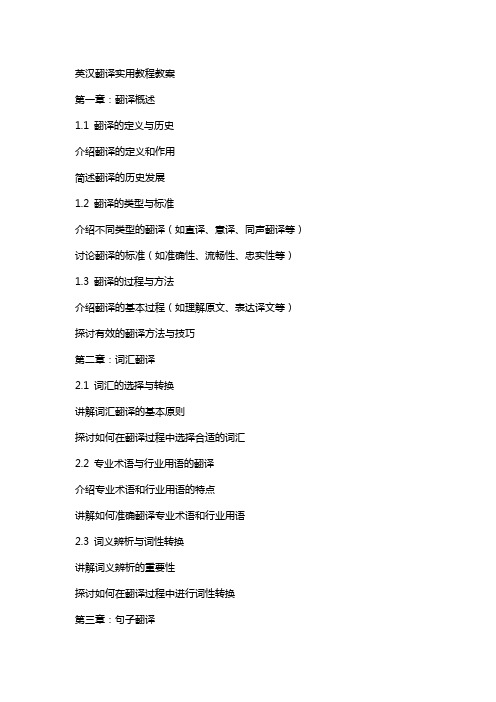
英汉翻译实用教程教案第一章:翻译概述1.1 翻译的定义与历史介绍翻译的定义和作用简述翻译的历史发展1.2 翻译的类型与标准介绍不同类型的翻译(如直译、意译、同声翻译等)讨论翻译的标准(如准确性、流畅性、忠实性等)1.3 翻译的过程与方法介绍翻译的基本过程(如理解原文、表达译文等)探讨有效的翻译方法与技巧第二章:词汇翻译2.1 词汇的选择与转换讲解词汇翻译的基本原则探讨如何在翻译过程中选择合适的词汇2.2 专业术语与行业用语的翻译介绍专业术语和行业用语的特点讲解如何准确翻译专业术语和行业用语2.3 词义辨析与词性转换讲解词义辨析的重要性探讨如何在翻译过程中进行词性转换第三章:句子翻译3.1 句型结构与句子成分讲解英语和汉语句型结构的差异探讨如何在翻译过程中保持句子成分的平衡3.2 语法调整与句子重构讲解语法调整的重要性探讨如何在翻译过程中进行句子重构3.3 意译与直译的运用讲解意译和直译的区别与适用场景探讨如何在翻译过程中灵活运用意译和直译第四章:段落与文章翻译4.1 段落结构与主题句的翻译讲解段落结构的重要性探讨如何翻译段落主题句4.2 逻辑与连贯性的保持讲解翻译过程中逻辑和连贯性的重要性探讨如何保持原文的逻辑和连贯性4.3 文章风格与翻译策略讲解不同文章风格的特征探讨如何根据文章风格选择合适的翻译策略第五章:文化差异与翻译5.1 文化背景与翻译讲解文化背景对翻译的影响探讨如何在翻译过程中考虑文化背景5.2 文化词汇与翻译讲解文化词汇的特点和翻译难点探讨如何准确翻译文化词汇5.3 跨文化交流与翻译实践讲解跨文化交流的重要性探讨如何在翻译实践中应对跨文化交流的挑战第六章:翻译技巧与策略6.1 翻译中的直译与意译深入探讨直译与意译的定义和应用场景分析直译与意译在实际翻译案例中的运用6.2 翻译中的归化与异化讲解归化与异化的概念和作用探讨如何在翻译过程中运用归化和异化策略6.3 翻译中的补偿与调整分析翻译中补偿与调整的必要性和方法通过实例展示补偿与调整在翻译中的应用第七章:文学翻译7.1 文学翻译的基本原则探讨文学翻译的特殊性和原则分析文学翻译中应注重的方面7.2 诗歌、小说、戏剧等文体的翻译深入讲解不同文学文体的翻译特点和技巧通过实例分析不同文学文体的翻译方法7.3 文学翻译案例分析分析具体文学作品的翻译案例讨论文学翻译中的难点和解决策略第八章:商务翻译8.1 商务翻译的基本要求讲解商务翻译的特点和基本要求分析商务翻译中应注重的方面8.2 商务合同、广告、报告等文体的翻译深入讲解不同商务文体的翻译特点和技巧通过实例分析不同商务文体的翻译方法8.3 商务翻译案例分析分析具体商务材料的翻译案例讨论商务翻译中的难点和解决策略第九章:口译技巧与实践9.1 口译的基本类型与技巧讲解同声传译、交替传译等口译类型的特点探讨口译过程中的技巧和策略9.2 口译中的听力理解与信息处理分析听力理解在口译中的重要性讲解如何提高口译中的信息处理能力9.3 口译实践案例分析提供口译实践案例,进行分析和讨论指导如何应对口译中的挑战和困难第十章:翻译软件与工具的使用10.1 翻译软件的种类与功能介绍市面上的主要翻译软件及其功能分析翻译软件的优缺点和使用场景10.2 翻译辅助工具的使用讲解翻译辅助工具(如在线词典、术语管理工具等)的运用探讨如何提高翻译效率和质量10.3 翻译软件与人工翻译的结合讨论翻译软件与人工翻译的结合方式分析如何利用翻译软件辅助人工翻译工作重点和难点解析6.1 直译与意译的界定和应用场景是教学中的重点和难点。
英汉对比与翻译(六讲,学生版)

提示:这些是上课用的材料,每次课前完成大约两讲的翻译练习。
独立完成,严禁抄袭!英汉对比与翻译一,形合(hypotaxis)与意合(parataxis)英汉语法最基本的差别是形合(hypotaxis)和意合(parataxis)对比。
重形合的语言注重以形显意,句子成分(包括单词、短语、分句)之间的逻辑关系靠关联词等显性连接手段来直接标示,句子结构比较严谨但缺少弹性;重意合的语言注意以意役形,句子各成分之间靠隐性连贯、逻辑关系和叙述的事理顺序来间接显示,不用或少用关联词,句子结构比较松散但富有弹性。
英译汉的主要过程是句法结构的转换,包括拆散、重组和间接手段由显变隐等步骤。
首先将英文句子的叠床架屋的空间搭架拆散成若干意群,然后将每个意群转换成汉语的一个短语、小句甚至句子,组合成汉语的节节推进的时间和逻辑序列。
值得注意的是,这种意群可以是英文句中的任何一个成分(分句、短语、单词)或若干个成分的综合,翻译中势必有所增删、调整。
在此过程中英文句中的关联词大部分不译,而转换成汉语句中隐含的关系即语气连贯。
汉译英的过程则相反,将汉语句子的时间和逻辑序列转换成英语句子的空间搭架,期间同样不可斤斤于字比句次。
具体说来,一是按照英语行文的需要重新分句,二是分析和确定每个句子中的不同成分间的逻辑关系,三是按照个陈分间的关系重新安排各个句子,使汉语句子的线性序列变成英语句子的空间构架。
同时,汉语中靠语序间接表示的隐性连接转换成用关联词标示的显性连接。
(蒋坚松2000:14)现代庄重文体、科技文体和论述文体较多采用形合句,以表达清晰的逻辑关系和复杂的思想内容。
(连淑能1993:60)Practice:1, His children were as ragged and wild as if they belonged to nobody. (W. Irving)2,Startled, he jumped up and hastened to the mirror in the bathroom, taking away the towel to examine the cut upon his cheek.3,跑得了和尚,跑不了庙。
英汉翻译第六章教案
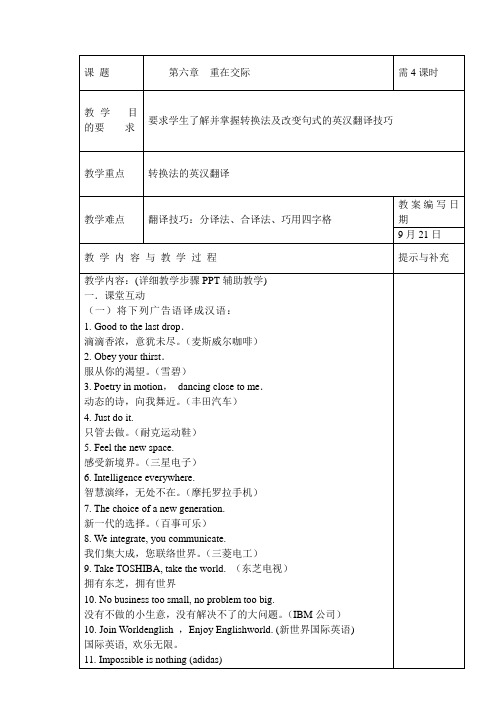
2. Obey your thirst.
服从你的渴望。(雪碧)
3. Poetry in motion,dancing close to me.
动态的诗,向我舞近。(丰田汽车)
4. Just do it.
只管去做。(耐克运动鞋)
5. Feel the new space.
对我而言,过去平淡无奇;而未来,却一直是彩色的(轩尼诗酒)
21. Ask for more.
渴望无限。(百事)
22. Let's make things better.
让我们做得更好。(飞利浦电子)
23.Time is what you make of it.(Swatch)
天长地久。(斯沃奇手表)
尽情享受吧!(雀巢)
18. The relentless pursuit of perfection.
不懈追求完美。(凌志轿车)
19. Come to where the flavour is.marlboro country.
光临风韵之境——万宝路世界。(万宝路)
20. To me,the past is black and white,but the future is always color.
9. Take TOSHIBA, take the world.(东芝电视)
拥有东芝,拥有世界
10. No business too small, no problem too big.
没有不做的小生意,没有解决不了的大问题。(IBM公司)
10. Join Worldenglish,Enjoy Englishworld. (新世界国际英语)
英汉翻译第六章教案
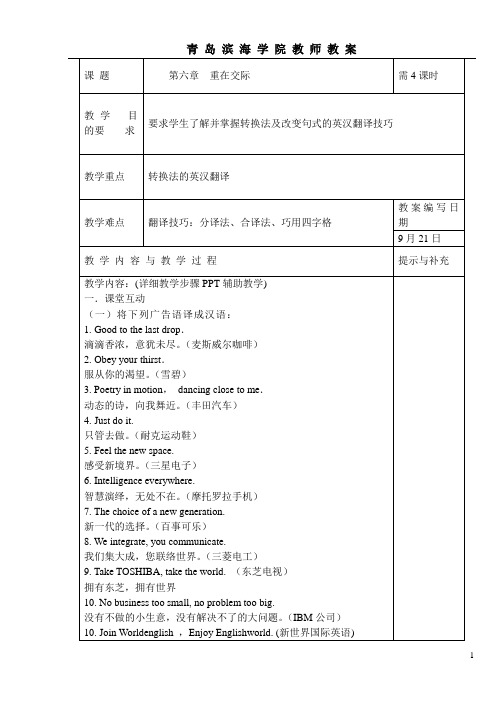
提示与补充
1
青 岛 滨 海 学 院 教 师 教 案
国际英语, 欢乐无限。 11. Impossible is nothing (adidas) 没有不可能! 12. Nothing can come of Nothing .(莎士比亚) 物有其本, 事有其源。 13. Buy Australia, Buy you a job.(澳大利亚) 买澳大利亚货,给你买份工作. 14. One world, One dream.(北京奥运会) 同一个世界,同一个梦想. 15. We lead. others copy. 我们领先,他人仿效。 (理光复印机) 16. Impossible made possible. 使不可能变为可能。 (佳能) 17. Take time to indulge. 尽情享受吧! (雀巢) 18. The relentless pursuit of perfection. 不懈追求完美。 (凌志轿车) 19. Come to where the flavour is. marlboro country. 光临风韵之境——万宝路世界。 (万宝路) 20. To me, the past is black and white, but the future is always color. 对我而言,过去平淡无奇;而未来,却一直是彩色的(轩尼诗酒) 21. Ask for more. 渴望无限。 (百事) 22. Let's make things better. 让我们做得更好。 (飞利浦电子) 23.Time is what you make of it.(Swatch) 天长地久。 (斯沃奇手表) 24. Make yourself heard.(Ericsson) 理解就是沟通。(爱立信) 24. Engineered to move the human spirit.(Mercedes-Benz) 人类精神的动力。 (梅塞德斯-奔驰) 25. Fresh-up with Seven-up.(Seven-up) 提神醒脑,喝七喜。 26. Connecting People.(Nokia) 科技以人为本。 (诺基亚) 27. For the Road Ahead.(Honda) 康庄大道。 28. The Relentless Pursuit of Perfection.教 案
英汉翻译教程讲解第六章
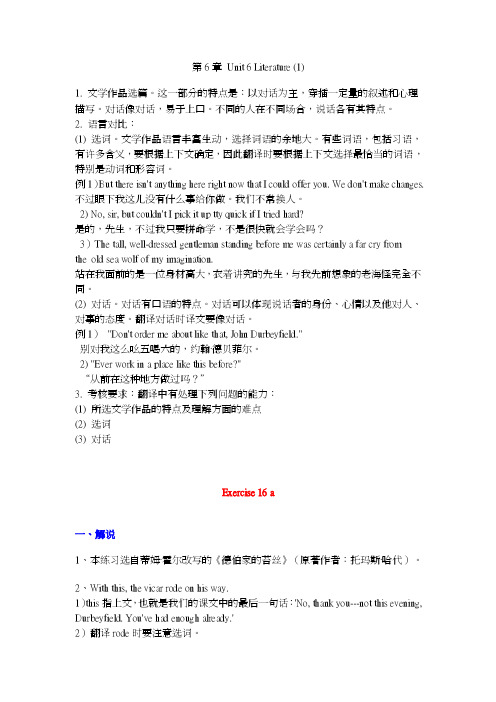
第6章Unit 6 Literature (1)1. 文学作品选篇。
这一部分的特点是:以对话为主,穿插一定量的叙述和心理描写。
对话像对话,易于上口。
不同的人在不同场合,说话各有其特点。
2. 语言对比:(1) 选词。
文学作品语言丰富生动,选择词语的余地大。
有些词语,包括习语,有许多含义,要根据上下文确定,因此翻译时要根据上下文选择最恰当的词语,特别是动词和形容词。
例1)But there isn't anything here right now that I could offer you. We don't make changes. 不过眼下我这儿没有什么事给你做。
我们不常换人。
2) No, sir, but couldn't I pick it up tty quick if I tried hard?是的,先生,不过我只要拼命学,不是很快就会学会吗?3)The tall, well-dressed gentleman standing before me was certainly a far cry fromthe old sea wolf of my imagination.站在我面前的是一位身材高大,衣着讲究的先生,与我先前想象的老海怪完全不同。
(2) 对话。
对话有口语的特点。
对话可以体现说话者的身份、心情以及他对人、对事的态度。
翻译对话时译文要像对话。
例1)"Don't order me about like that, John Durbeyfield."别对我这么吆五喝六的,约翰·德贝菲尔。
2) "Ever work in a place like this before?"“从前在这种地方做过吗?”3. 考核要求:翻译中有处理下列问题的能力:(1) 所选文学作品的特点及理解方面的难点(2) 选词(3) 对话Exercise 16 a一、解说1、本练习选自蒂姆·霍尔改写的《德伯家的苔丝》(原著作者:托玛斯·哈代)。
新英汉翻译课件教程 Chapter 6 词义的处理

• • • •
例4:He didn’t speak (for) long. 【误】他长时间没有说话了。 【正】他说话时间不长。 【解析】英语中有些词或词组只用于肯定句,要用在否
定句,有时就成了错句,意思也发生了变化。“(for)a long time” 在否定句中改用 “for long”,如 “He stayed in the U.S.A. (for) a long time.”(他在美国呆了 很长时间。)“He didn’t stay in the U.S.A. (for )long.” (他在美国呆的时间不长。)有时“for a long time” 也 可用于否定句,但意义不同,意为 “长时间未做某事”。 如 “He didn’t speak (for) a long time.”(他长时间没 有说话了。)
6. 1. 2 词义选择,注重词性
词义选择就是用最恰当词汇表达再现原文, 这是翻译中最难掌握且十分重要、很有意义的部 分。怎样去选择词义,首先要根据其主要词性、 语法作用、词与词的搭配等来确定。 A. 动词 (Verbs) 动词意义的选择要看该动词使用的频率,程 度的大小,分量轻重,语气的强弱,词的搭配、 字面意义、比喻隐含意义等。
• 9. Everything was working very smoothly and I felt on top oபைடு நூலகம் the world. • A.一切进展顺利,我感到在世界顶端。 • B.一切进展顺利,我感到满意极了。 • 10. There is no provocation for such an angry letter. • A.没有理由写这样一封怒气冲冲的信。 • B.别写这样一封使人生气的信。 • C.不必对这样一封令人气愤的信而发火。
【VIP专享】《英汉互译(二)》教案与讲义第6讲
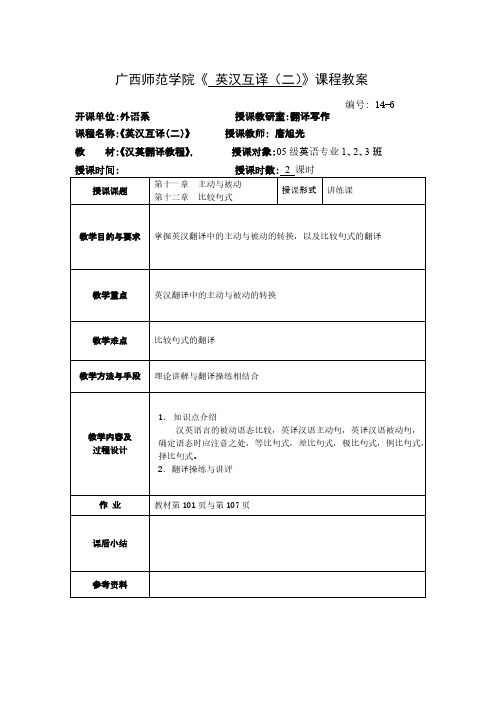
广西师范学院《英汉互译(二)》课程教案编号: 14-6 开课单位:外语系授课教研室:翻译写作课程名称:《英汉互译(二)》授课教师:唐旭光教材:《汉英翻译教程》,授课对象:05级英语专业1、2、3班授课时间:授课时数: 2 课时授课课题第十一章 主动与被动第十二章 比较句式授课形式讲练课教学目的与要求掌握英汉翻译中的主动与被动的转换,以及比较句式的翻译教学重点英汉翻译中的主动与被动的转换教学难点比较句式的翻译教学方法与手段理论讲解与翻译操练相结合教学内容及过程设计1.知识点介绍汉英语言的被动语态比较,英译汉语主动句,英译汉语被动句,确定语态时应注意之处,等比句式,差比句式,极比句式,例比句式,择比句式。
2. 翻译操练与讲评作业教材第101页与第107页课后小结参考资料英汉互译(二)第6讲第一步:上周练习讲评:第二步:本周课堂内容呈现第十一章 主动与被动一、汉英语言的被动语态比较汉英两种语言的被动语态使用比较汉语的被动句作为一种特殊句型,较少使用,它的使用同陈述的对象和语境有密切的关系。
受事作为陈述的对象,宜用被动句。
而英语的被动句常用于以下场合:(1)句子的重心是事件本身而非施动者(2)施动者不明或不提及施动者(3)为了强调施动者,用带by+词组的被动句(4)受上下文和语境的支配2. 汉英两种语言被动语态的表达方式比较(1)汉语被动语态的两种表达方式:(汉语使用被动句,原因:强调受事,施事不需说,不愿说,无从说;在特定的上下文中,为了使前后分句的主语保持一致,为了使叙述的重点突出,达到语意连贯,语气流畅。
)<1>有形式标志的被动语态:被、受、把、挨等等。
<2>没有形式标志的被动语态(2)英语被动语态的两种表达方式:Be型被动态Get型被动态二、英译汉语主动句(汉语主动句的谓动词事没有限制的;而被动句的谓语动词则是有限制的,全句一般表示不怎么情愿的意思。
)1. 汉语主动句译成英语主动句2.汉语主动句译成英语被动句的情形(1)保留原文主语,强调被动者(2)突出原文宾语,将宾语置于主语的位置,动词用被动语态(3)无具体施动者的汉语无主句译成英语被动句<1>动宾结构的无主句译成英语被动句<2>一些表示要求、规定的无主句译成英语被动句<3>表示事物存在的无主句译成英语被动句(4)汉语中概括、泛指性的词(“有人”“人们”“人人”“大家”“我们”)充当主语时,可译成宾语换作主语的被动句或“it”为形式主语的被动句(5)使语气委婉,措辞礼貌(6)某些汉语句子可借助于英语的一些固定搭配或词组来表达三、英译汉语被动句1. 汉语被动句译为英语主动句(1)为了符合英语的表达习惯(2)受上下文和语境的支配2. 汉语被动句译成英语被动句四、确定语态时应注意之处1. 一些汉语形式上是主动句,但含义上是被动的句子,宜译成英语被动语态;2. 一些汉语形式上是主动句,但含义上是被动的句子,可以利用英语的某些不及物动词或特殊用法的动词,也译成英语形式上是主动,但含义上是被动的句子;(1)deserve, require,want,need等,这些带有被动含义的动词。
英语专业英译汉---第六章增减词解析公开课获奖课件百校联赛一等奖课件

活动→多种活动 样品→多种样品 型号→多种型号 问题→这些问题 矛盾→这些矛盾 书籍→各类书籍 尺寸→各类尺寸 内容→各项内容 指标→各项指标 情况→种种情况 原因→种种原因
5 补译省略部分
原文为使语言简洁,防止反复而 省掉了一种或几种词、词组。汉译时 补译出原文所省略之词,会使译文意 思清楚明确、生动有力,具有行文优 美、构造完整之感。
例1:It is enough to shatter complacency.
【译文】足以打破自满情绪。
例2: stillness confusion measurement purification repetition management calculation accommodation joint saturation preparation remedies modification
seize, and enjoy every moment of it.
【译文】懂得时间旳真正价值。才干争取每一 刻,抓住每一刻,享有每一刻。
补充例句
例1:Time is treated as if it were something almost real. We budget it, save it, waste it, steal it, kill it, cut it, account for it; we also charge for it.
例1:We admire him for the way in which he faces his difficulties.
【译文】我们赞赏他面对多种困难旳做法。
例2: activities samples types problems contradictions books sizes contents targets circumstances causes
《英汉互译》教案与讲义
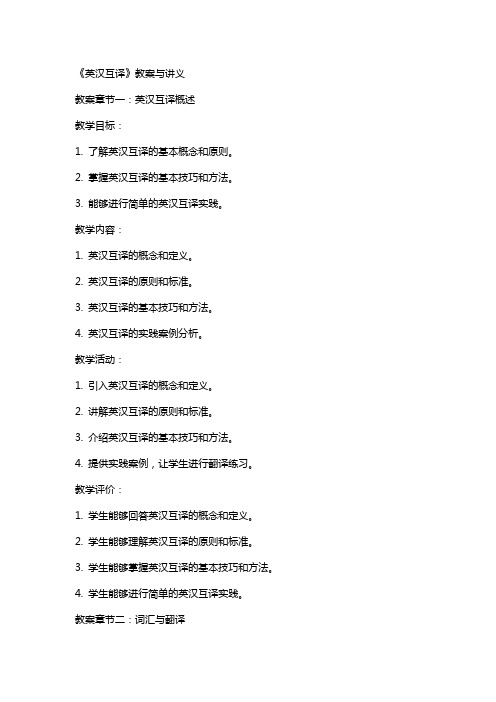
《英汉互译》教案与讲义教案章节一:英汉互译概述教学目标:1. 了解英汉互译的基本概念和原则。
2. 掌握英汉互译的基本技巧和方法。
3. 能够进行简单的英汉互译实践。
教学内容:1. 英汉互译的概念和定义。
2. 英汉互译的原则和标准。
3. 英汉互译的基本技巧和方法。
4. 英汉互译的实践案例分析。
教学活动:1. 引入英汉互译的概念和定义。
2. 讲解英汉互译的原则和标准。
3. 介绍英汉互译的基本技巧和方法。
4. 提供实践案例,让学生进行翻译练习。
教学评价:1. 学生能够回答英汉互译的概念和定义。
2. 学生能够理解英汉互译的原则和标准。
3. 学生能够掌握英汉互译的基本技巧和方法。
4. 学生能够进行简单的英汉互译实践。
教案章节二:词汇与翻译1. 了解词汇在英汉互译中的重要性。
2. 掌握英汉词汇的差异和转换方法。
3. 能够准确翻译词汇和短语。
教学内容:1. 词汇在英汉互译中的作用和重要性。
2. 英汉词汇的差异和转换方法。
3. 常见词汇和短语的翻译实例。
教学活动:1. 引入词汇在英汉互译中的作用和重要性。
2. 讲解英汉词汇的差异和转换方法。
3. 提供常见词汇和短语的翻译实例。
4. 让学生进行词汇翻译练习。
教学评价:1. 学生能够理解词汇在英汉互译中的重要性。
2. 学生能够掌握英汉词汇的差异和转换方法。
3. 学生能够准确翻译常见词汇和短语。
教案章节三:语法与翻译教学目标:1. 了解语法在英汉互译中的重要性。
2. 掌握英汉语法的差异和转换方法。
3. 能够正确翻译句子和段落。
1. 语法在英汉互译中的作用和重要性。
2. 英汉语法的差异和转换方法。
3. 常见语法错误的分析和纠正。
教学活动:1. 引入语法在英汉互译中的作用和重要性。
2. 讲解英汉语法的差异和转换方法。
3. 提供常见语法错误的分析和纠正。
4. 让学生进行句子和段落的翻译练习。
教学评价:1. 学生能够理解语法在英汉互译中的重要性。
2. 学生能够掌握英汉语法的差异和转换方法。
《英汉互译》教案与讲义

《英汉互译》教案与讲义一、教学目标:1. 让学生掌握英汉互译的基本原则和方法。
2. 提高学生对英汉两种语言的差异性的认识,增强跨文化交际能力。
3. 通过实践练习,提高学生的英汉互译技巧,使其能够准确、流畅地进行英汉互译。
二、教学内容:1. 英汉互译的基本原则:忠实于原文、保持语义完整、符合目标语言的表达习惯。
2. 英汉两种语言的差异性:词汇、语法、表达习惯、文化背景等。
3. 英汉互译的方法:直译、意译、借译、创译等。
4. 英汉互译的技巧:词汇转换、语法调整、表达方式的改变、文化背景的适应等。
三、教学方法:1. 讲授法:讲解英汉互译的基本原则、方法和技巧。
2. 案例分析法:分析具体英汉互译案例,讲解其翻译过程和思路。
3. 实践练习法:学生进行英汉互译练习,教师进行指导和点评。
四、教学准备:1. 教学PPT:包含英汉互译的基本原则、方法和技巧等内容。
2. 英汉互译案例:用于分析和实践练习。
3. 学生练习材料:提供相关文章、段落等,供学生进行英汉互译练习。
五、教学步骤:1. 导入:简要介绍英汉互译的重要性和必要性。
2. 讲解:讲解英汉互译的基本原则、方法和技巧。
3. 案例分析:分析具体英汉互译案例,讲解其翻译过程和思路。
4. 实践练习:学生进行英汉互译练习,教师进行指导和点评。
六、教学评估:1. 课堂参与度:观察学生在课堂上的发言和讨论情况,评估其对英汉互译知识的理解和应用能力。
2. 练习完成情况:评估学生在实践练习中的翻译质量,包括准确性、流畅性和地道性等方面。
3. 课后作业:布置相关英汉互译作业,评估学生的翻译能力和对知识的掌握程度。
七、教学拓展:1. 推荐阅读材料:提供相关的英汉互译书籍、文章等,供学生进一步学习和深入了解。
2. 实践项目:鼓励学生参与实际的英汉互译项目,提高其实际操作能力和经验。
3. 交流与讨论:组织学生进行英汉互译经验的交流和讨论,促进相互学习和共同进步。
八、教学资源:1. 教材:选择适合的英汉互译教材,提供系统的学习内容和案例分析。
- 1、下载文档前请自行甄别文档内容的完整性,平台不提供额外的编辑、内容补充、找答案等附加服务。
- 2、"仅部分预览"的文档,不可在线预览部分如存在完整性等问题,可反馈申请退款(可完整预览的文档不适用该条件!)。
- 3、如文档侵犯您的权益,请联系客服反馈,我们会尽快为您处理(人工客服工作时间:9:00-18:30)。
广西师范学院《英汉互译(二)》课程教案编号: 14-6 开课单位:外语系授课教研室:翻译写作课程名称:《英汉互译(二)》授课教师:唐旭光教材:《汉英翻译教程》,授课对象:05级英语专业1、2、3班英汉互译(二)第6讲第一步:上周练习讲评:第二步:本周课堂内容呈现第十一章主动与被动一、汉英语言的被动语态比较汉英两种语言的被动语态使用比较汉语的被动句作为一种特殊句型,较少使用,它的使用同陈述的对象和语境有密切的关系。
受事作为陈述的对象,宜用被动句。
而英语的被动句常用于以下场合:(1)句子的重心是事件本身而非施动者(2)施动者不明或不提及施动者(3)为了强调施动者,用带by+词组的被动句(4)受上下文和语境的支配2. 汉英两种语言被动语态的表达方式比较(1)汉语被动语态的两种表达方式:(汉语使用被动句,原因:强调受事,施事不需说,不愿说,无从说;在特定的上下文中,为了使前后分句的主语保持一致,为了使叙述的重点突出,达到语意连贯,语气流畅。
)<1>有形式标志的被动语态:被、受、把、挨等等。
<2>没有形式标志的被动语态(2)英语被动语态的两种表达方式:Be型被动态Get型被动态二、英译汉语主动句(汉语主动句的谓动词事没有限制的;而被动句的谓语动词则是有限制的,全句一般表示不怎么情愿的意思。
)1. 汉语主动句译成英语主动句2.汉语主动句译成英语被动句的情形(1)保留原文主语,强调被动者(2)突出原文宾语,将宾语置于主语的位置,动词用被动语态(3)无具体施动者的汉语无主句译成英语被动句<1>动宾结构的无主句译成英语被动句<2>一些表示要求、规定的无主句译成英语被动句<3>表示事物存在的无主句译成英语被动句(4)汉语中概括、泛指性的词(“有人”“人们”“人人”“大家”“我们”)充当主语时,可译成宾语换作主语的被动句或“it”为形式主语的被动句(5)使语气委婉,措辞礼貌(6)某些汉语句子可借助于英语的一些固定搭配或词组来表达三、英译汉语被动句1. 汉语被动句译为英语主动句(1)为了符合英语的表达习惯(2)受上下文和语境的支配2. 汉语被动句译成英语被动句四、确定语态时应注意之处1. 一些汉语形式上是主动句,但含义上是被动的句子,宜译成英语被动语态;2. 一些汉语形式上是主动句,但含义上是被动的句子,可以利用英语的某些不及物动词或特殊用法的动词,也译成英语形式上是主动,但含义上是被动的句子;(1)deserve, require,want,need等,这些带有被动含义的动词。
(2)英语一些动词和表示行为方式的状语连用,表示被动意义(3)英语一些动词,如blow,cook, drive, expand, fill, shape, show, widen,等的进行时态表示被动意义第十二章比较句式说明:1. 汉语的比较句靠词汇手段,英语的比较句不仅靠词汇手段,还需要词缀手段;2. 汉语比较句式变化形式少,不明显,英语比较句变化形式多,语法特征明显;3. 汉语多用极比句式,而英语不太爱用绝对的肯定或否定,爱用相对比较。
一、等比句式(comparison of equality)1. 水面像空气一般平静,像绸缎般华丽。
The water was smooth as air, gaudy as silk.2. 这跟我事先希望的一样成功。
It was as much of a success as I had hoped.二、差比句式(comparison of difference)1. 他需要的钱很多,连他在铁路上干活所挣的钱也不够。
He needed more money than he was earning at his railroad job.2. 他比我年长十岁。
He is ten years senior to me.三、极比句式(comparison of extremity)1.他是探险者中走得最远的人。
He went furthest of the explorers.2. 这事在我们最难预料的时候发生了。
It happened just when we least expected.四、例比句式(comparison of proportion)1. 动身越早,回来越早。
The earlier you start, the sooner you’ll be back.2. 他越是为自己辩护,大家就越不相信他。
He was believed less as his defense grew more complicated.五、择比句式(comparison of preference)1. 她与其说是受了伤,还不如说是吓坏了。
She was less hurt than frightened.最叫我痛心的,倒不是这件事本身,而是他们说谎。
What hurt me worst about it was not so much as their lying.第三步:本周课堂翻译练习一、翻译下列句子1 这事儿说起来容易做起来难.It’s easier said than done.2 我们是昨天在会所里开了一个会议.It was yesterday that we held a meeting in the club.3 英语晚会已延期到星期六举行.The English Evening has been put off till Saturday.4 中国在四千年前发明了指南针.The compass was invented in China four thousand years ago.5总是在失去友谊时才感到真正友谊的可贵.The value of true friendship is seldom known until it is lost.6 据说不少人妒忌汤姆的才识It is said that Tom’s wisdom is the envy of a lot of people.7 一般认为这样做时不妥的.It is generally considered not have discovered this phenomenon.8 很难说他们已经发现这一现象了.They can hardly be said to have discovered this phenomenon.9 人人都知道世界时由物质构成的.It is universally known that the world is made of matter.10 他一生致力于做学问.His entire life was devoted to learning,11 考完试,我觉得很轻松.The examination being over, I feel greatly relieved.12 在举行个别交谈之前,我已经就所有要讨论的问题预先拟好了备忘录.Memoranda were prepared in advance of private meetings on matters to be discussed.13 马路两旁是整齐的梧桐树.The avenue was lined with neatly-spaced plane trees14 组建了一个专门委员会来领导这次运动.A special committee has been formed to direct the campaign.15 在这些文件中,没有发现任何缺陷.No defects have been found in these documents.二、翻译下列带有比较句子1. 今天老师高于学生,明天学生可以高于老师,这就是辩证法。
It is a law of dialectics that a teacher may be superior to his pupils today, while the latter may be superior to the former tomorrow.2.我们都知道,储存在计算机里的信息跟计算机同样重要。
As we all know ,a computer is not better than the information stored in it.3.他宁可放弃休假,也要把工作做完。
He would rather give up his holidays than not finish his work..4.人们在家里看电视,如同去电影院看电影。
One may as well watch TV at home as go to cinema.5.宁为玉碎,不为瓦全。
It is better to be clothed in rages than clothed with shame.6.肥料对于植物,犹如事物对于人。
Fertilizers are to the plant what food is to men.7.那时候的学生里面,有几位年龄比我还大Some of the students were older than I then.8.海洋分割了世界,但更连接了世界。
The oceans do not as much divide the world as unite it.9.一个人懂得越多,越是发现自己的不足。
The more one knows the more he discovers his ignorance.10.眼下最重要的事情莫过于给白宫传递谈判的信号。
Nothing is more important right now than the signal to the White House for a negotiation.11.一个人年龄越大,到过的地方越多,他的经历就会越丰富。
The older one gets and the more widely traveled he is , the more experienced he would be.12.这种测量方法既实用又简单。
The method of measurement is as simple as practical13.任何国家的文明,外来的影响总是远远多于本国的发明。
The civilization of any country is much more the product of external influence than of native invention.教材:“汉英翻译教程”朱徽,重庆大学出版社,2006。
